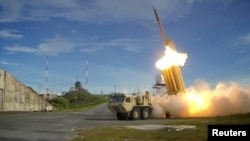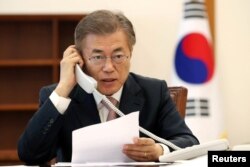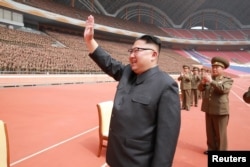In the face of North Korea's escalating nuclear weapons threat, the leaders of the United States and South Korea are expected to bridge their differences on the North during a summit next month, experts say.
Last week, a spokesman for South Korea's recently elected President Moon Jae-in, of the liberal Democratic Party of Korea, said a summit with President Donald Trump was arranged for late June in Washington, but the White House has not confirmed the meeting.
South Korea has been alarmed by several ballistic missile tests by Pyongyang, with the latest being the launch of a new intermediate-range solid-fuel rocket, conducted Sunday.
North Korea's official news agency, KCNA, says the missile that traveled about 500 kilometers (310 miles) in the direction of the Sea of Japan and reached an altitude of 560 kilometers (348 miles), satisfied all technical requirements and can be mass produced, suggesting progress in its ambition to be capable of striking the United States.
“There clearly are some issues that will need to be addressed early in the tenure of President Moon Jae-in,” Alexander Vershbow, who was U.S. Ambassador to Seoul between 2005 and 2008, told VOA's Korean Service. “The Moon Jae-in visit will focus, first and foremost, on how to ensure a unified approach, on the question of how to engage Pyongyang, what mix of carrots and sticks.”
THAAD deployment
The starkest division between Trump and Moon is the deployment of the Terminal High Altitude Area Defense (THAAD) anti-missile system to South Korea.
Moon said in his inauguration speech he would have “serious negotiations” with Washington and Beijing over the missile shield. But the U.S. State Department recently reaffirmed its previous position, telling VOA Korean Washington and Seoul made “an Alliance decision” to deploy THAAD as a purely defensive measure “to protect the security of South Korea and its people from armed attack and to protect Alliance military forces” from North Korea's missile threats.
“I think the South Korean public recognizes that the reason for THAAD is the threat posed by North Korea's missiles, which can threaten not only South Korean cities, but also U.S. forces,” said Vershbow, who is now with the Atlantic Council, a research institute.
Moon, a former human rights lawyer, has long been an advocate of engagement and dialogue with Pyongyang while also seeking sanctions. Trump appears to be putting great emphasis on convincing China to ratchet up pressure on the North.
“In Washington, there are questions, even concerns, about President Moon's approach toward North Korea, given that he was chief of staff to (former President) Roh Moo-hyun,” Bruce Klingner, a former CIA deputy division chief for Korea, told VOA Korean. During a period when President George W. Bush pursued an approach that reflects Trump's, “there were a number of strains (in the relationship between Washington and Seoul), given Roh's largely unconditional engagement with North Korea.”
But because Moon has many times said he is open to meeting North Korea's leader Kim Jong Un “under the right conditions,” a position Trump espoused in a recent interview with Bloomberg News, the two leaders may agree on defending against a common threat as well as enforcing international and U.S. sanctions against Pyongyang, added Klingner, who is now with The Heritage Foundation's Asian Studies Center.
Talks and pressure
Scott Snyder, a Korean studies analyst at the Council on Foreign Relations, notes Moon has not disavowed putting pressure on North Korea, saying, “He's even suggested that the pressure is an important tool that can be used in order to achieve the conditions that are necessary to resume dialogue.”
But as economic interaction or the relaxation of sanctions in some form would be an important inducement for North Korea to move forward from a South Korean perspective, Seoul's engagement strategy could be in conflict with U.S. strategy that initially focuses on pressure, Snyder said.
A spokesman for South Korea's Unification Ministry said Monday it will consider allowing non-governmental exchange with the North, but only within the scope of international sanctions against Pyongyang. In 2010, Seoul imposed broad sanctions against Pyongyang in retaliation for the Kim regime's alleged attack on a South Korean navy ship. The so-called “May 24 Measure” banned nearly all exchanges between the two Koreas.
Speaking to VOA Korean, Joseph DeTrani, a former U.S. special envoy for six-party talks with North Korea, said given an ever more threatening regime, the reality compels the two allies to coordinate their approach that would get “North Korea to come back to meaningful negotiations (and) to talk about comprehensive, verifiable denuclearization,” the only strategy he believes could halt Kim's pursuit of nuclear weapons.
(This report originated with the VOA Korean Service.)










